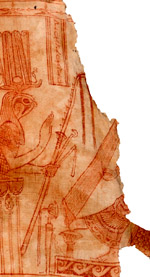Maria Mossakowska-Gaubert (Editor)
This volume presents the results of a workshop, which took place on November 24, 2017 at the Centre for Textile Research (CTR), University of Copenhagen. The event was organised within the framework of the MONTEX project1—a Marie Skłodowska-Curie individual fellowship conducted by Maria Mossakowska-Gaubert in collaboration with the Contextes et Mobiliers programme of the French Institute for Oriental Archaeology in Cairo (IFAO), and with support from the Institut français du Danemark and the Alexander von Humboldt Foundation.
Bringing together archaeologists, historians, philologists and papyrologists, this work compares different points of view on raw materials, looms, the technology of weaving and dyeing, as well as the organisation of textile production in Egypt in the Hellenistic, Roman and Byzantine periods. It also involves an attempt to identify a “word” with an “object”. Indeed, when an “archaeological object” is mentioned, what first comes to mind are its form, the way it is produced and decorated, and lastly the way in which it is used. It is quite unusual for archaeological publications to ask what the object was called. Meanwhile, both literary and documentary texts offer an exceptional abundance of words defining such items. However, the lexicographical interpretation of the terms proposed in dictionaries does not always correspond with the chronological, geographical, or technological realities that determined the production and usage of the investigated artefacts.
In order to provide answers to some of these issues, the present volume includes new material from excavations with innovative interpretations, recent studies on material from collections, experimental dyeing and weaving investigations, presentations of iconographical material, as well as historical and sociological studies based on papyrological documentation and literary texts. It also contains lexicographical research into Greek and Coptic vocabulary.
This volume presents the results of a workshop, which took place on November 24, 2017 at the Centre for Textile Research (CTR), University of Copenhagen. The event was organised within the framework of the MONTEX project1—a Marie Skłodowska-Curie individual fellowship conducted by Maria Mossakowska-Gaubert in collaboration with the Contextes et Mobiliers programme of the French Institute for Oriental Archaeology in Cairo (IFAO), and with support from the Institut français du Danemark and the Alexander von Humboldt Foundation.
Bringing together archaeologists, historians, philologists and papyrologists, this work compares different points of view on raw materials, looms, the technology of weaving and dyeing, as well as the organisation of textile production in Egypt in the Hellenistic, Roman and Byzantine periods. It also involves an attempt to identify a “word” with an “object”. Indeed, when an “archaeological object” is mentioned, what first comes to mind are its form, the way it is produced and decorated, and lastly the way in which it is used. It is quite unusual for archaeological publications to ask what the object was called. Meanwhile, both literary and documentary texts offer an exceptional abundance of words defining such items. However, the lexicographical interpretation of the terms proposed in dictionaries does not always correspond with the chronological, geographical, or technological realities that determined the production and usage of the investigated artefacts.
In order to provide answers to some of these issues, the present volume includes new material from excavations with innovative interpretations, recent studies on material from collections, experimental dyeing and weaving investigations, presentations of iconographical material, as well as historical and sociological studies based on papyrological documentation and literary texts. It also contains lexicographical research into Greek and Coptic vocabulary.

